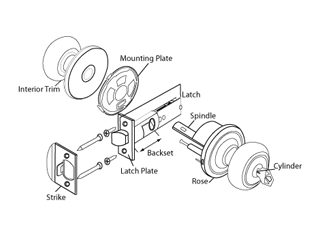Bolt – The metal piece that extends and secures a door
Cam – A flat piece fastened to the back of a mortise cylinder plug or mortise cylinder thumbturn. When rotated, it engages the lock mechanism and either locks or unlocks.
Case – The housing of a lock.
Cylinder – The round portion of the lock that accepts the key and enables the locking mechanism.
Cylinder Body. The portion of a cylinder that surrounds the plug and contains the tumbler mechanism.
Cylinder Plug. A tubular portion of the cylinder which rotates within the cylinder body when the correct key is inserted into it and turned.
Cylinder Guard – Material that surrounds the otherwise exposed portion of a cylinder to protect the cylinder from wrenching, cutting, pulling, or prying.
Cylinder Housing– The portion of a lock that surrounds and retains the cylinder body. It can be a knob, part of the lock case or other anchoring means.
Deadbolt – A lock bolt that is moved by turning a knob or key
Single cylinder deadbolt – A deadbolt back that is locked with a key from the outside of the home and a thumbturn on the inside.
Double cylinder deadbolt – Deadbolt that is operated with a key from both the outside and inside of the home.
Door Pull – A device applied to the face of a door which when grasped permits the user to pull a door open.
Handleset – The exterior door hardware that has a grip or, handle along with a deadbolt function to lock the door. When ordering, be sure to also add the corresponding interior ‘trim’
Interior Trim – The knob or lever attached to the inside of the door.
Interconnected Lock– (Also known by a number of different trade names ie. Emergency egress) A lock having a separate latch and dead bolt mechanically interconnected and installed in round bored openings in the face and edge of a door. It is best known for providing dead bolt security with the life safety feature of simultaneous retraction. When the dead bolt is projected, a single turn of the inside Lever retracts both the dead bolt and the latch bolt. This simultaneous retraction function is also available with some functions of the Rockwell Multipoint locks. Kick Plate. A door protection plate providing protection against the lower portion of the door. 8″, 10″, 12″ and 16″ heights are typical. The use of 16″ high kick plates is recommended for use on doors used by people in wheel chairs.
Knobset – The door hardware that includes the inside and outside knobs
Latch – The mechanism that secures the door when the door is closed. Most products come standard with an adjustable latch, allowing the hardware to be used on doors with either a 2-3/8″ backset or a 2-3/4″ backset. (The backset is the measurement from the edge of the door to the center of the predrilled hole.)
Latchplate– The metal sheet that surrounds the bolt and is mounted to the door edge
Leverset – The door hardware that includes the inside and outside levers Latchplate
Mortise Dead Latch– An auxiliary lock fitting a cavity prepared in the edge of the door and having a dead latch operated by a key or thumbturn both. The key or thumbturn engages the lock through holes prepared in the faces of the door.
Mortise Dead Lock– An auxiliary lock having a deadbolt instead of a dead latch. Deadbolt could also bee a hook type bolt.
Mortise Lock – A lock body typically rectangular in shape in the cavity an the edge of a door. A round or oval hole in the face of the door receives a spindle to which knobs or levers are attached. Available typically with a thumbturn on the interior.
Multipoint Locks – Lock body typically mounted in the face of the door with a latch and deadbolt plus additional locking or latching points top and bottom.
Mounting Plate – The mounting plate installs on the inside face of the door and holds the interior door trim in place.
Push Bar– Similar to a Pull Bar but used for pushing a door open
Rose – The plate surrounding the knob or lever that is flush against the door.
Strike – The metal hardware that is mounted to the door frame to receive the latch and/or bolt


